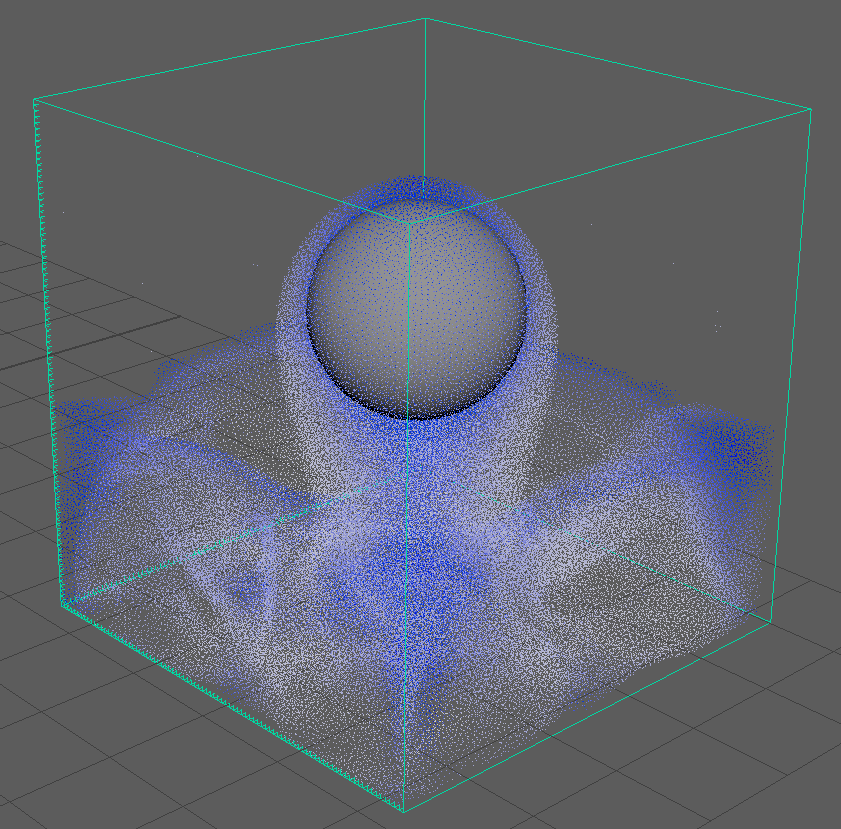This page has information about simulators, the building blocks of a Chaos Phoenix simulation.
Overview
A Simulator is a Phoenix object that controls the simulation, and enables you to create fluids like liquids and gasses that interact with the surrounding environment.
You can think of a Phoenix Simulator as a 3D box, inside which simulations of fluids and Rigid Body Dynamics are performed. The box is divided into small cells, called voxels, which is why the box is referred to as a Simulation Grid. The voxels inside the grid can be filled with just about any type of gas or liquid.
For each frame in your simulation, Phoenix looks at each voxel and calculates whether there is any fluid there, based on the settings you give the Phoenix sim. The simulator will also account for obstacles, such as geometry, as well as participating forces in the scene, and so forth.
Phoenix Simulators are divided into two types:
- Fire/Smoke Simulators, which can produce gaseous effects like fire, smoke and explosions, as well as sparks or embers and so forth.
- Liquid Simulators, which can create pouring or flowing liquids, or any simulation that needs foam or mist, such as coffee or waterfalls.
To actually create a simulation, three different components must be combined:
A Fire/Smoke Simulator or Liquid Simulator node
A Fire Source or Liquid Source node
An Emitter
This is the minimum requirement for just about any simulation setup.
Note that the workflow for Phoenix fluids and Active Bodies is split into two main parts – simulating and rendering.
Creating a Simulator
The Fire/Smoke, Liquid Simulator and the 2D Simulator can be created from the Phoenix FD menu → Create menu.
Another way to create a Simulator is to click the Fire/Smoke Simulator or Liquid Simulator button in the Phoenix Shelf, then draw on screen as if you are creating a box. The length, width, and height of the grid are set by the size of the Simulator. The Grid Size can be changed afterward, in the Simulator object's Attribute Editor.
The Simulator should contain the object which will emit the fire or liquid, and the area into which the fire or liquid will flow. The simulation will be contained completely inside the grid.
Fire/Smoke Simulator
Liquid Simulator
Note that in addition to the manual creation of a Simulator, a Simulator is automatically created when any of the Quick Simulation Setup buttons are used.
Cache Files
When running a simulation, the Simulator will typically output an entire animation sequence. That sequence is saved as individual files, called caches, which contain raw simulation data for each timeline frame. In essence, the cache data contains grids and particles, which describe the fluid’s behavior.
Rendering
Simulated cache files containing either Fire/Smoke simulations or Liquid simulations can be previewed in the viewport. The cache files can also be rendered to convert the raw simulation data into captivating and realistic images.
When rendering, the Phoenix Simulator offers multiple render modes. The Mesh Render Mode is typically used for rendering Liquids, and the Volumetric Render Modes are typically used for rendering Fire/Smoke simulations. Phoenix offers a lot of flexibility though, so there is the option to render Fire/Smoke simulations as meshes and Liquids as volumes, in order to achieve even more diverse effects.
When rendering other particle types besides Phoenix Liquid Particles, Phoenix has a separate Particle Shader geometry type, which is used to shade particles.




